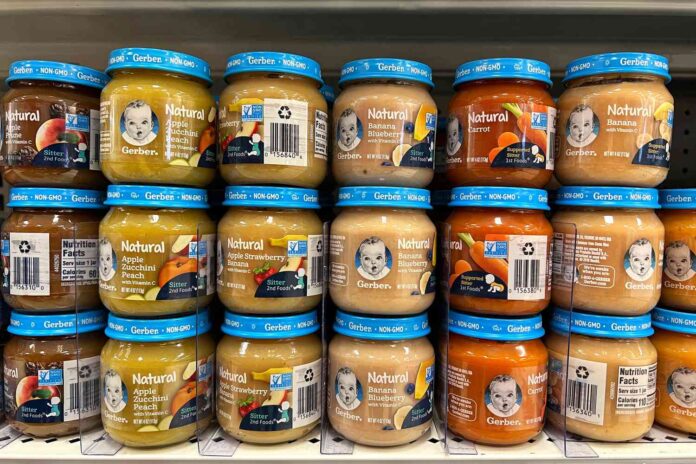:max_bytes(150000):strip_icc():format(jpeg)/Study-Finds-Majority-of-US-Baby-Foods-Dont-Meet-Nutritional-Guidelines-FT-BLOG0824-b62a1db14b1e4026bf6d932ad0dc2a09.jpg)
Parents of babies and infants may want to pay closer attention when strolling the aisles of grocery stores, according to a new study from The George Institute for Global Health. Published in Nutrients, an international and peer-reviewed journal focused on nutrition, on August 21st, the study indicates that a majority of infant and toddler foods in United States grocery stores fail to meet recommended nutritional guidelines set out by the World Health Organization (WHO).
The research considered 651 different food products across ten major US supermarkets, including Walmart, Target, Kroger, Costco, and Aldi, ultimately finding not only that 60% failed to meet the nutritional stipulations outlined by the WHO’s nutrient and promotion profile model (NPPM), but that none of them met the NPPM’s requirements for promotions — meaning certain items may have misleading marketing claims on them, giving the impression that they’re healthier than they actually are.
The NPPM details both recommended nutrition needs and promotional guidelines for children aged 6–26 months, and is intended to help efface policy changes in Europe so that countries may improve their nutritional standards. WHO NPPM guidelines focus on reducing sugar content and inclination towards a sweet flavor profile, and also set out metrics “to ensure appropriate energy density, salt, protein and fat contents across product categories.” The exact NPPM requirements can be seen here, but include specifications such as no added free sugars or sweeteners, and a maximum sodium content of 50 mg/100 kcal. Currently, there are no nutritional or promotional guidelines for commercial foods for infants and toddlers in the US.
Although the George Institute notes that different food products varied in their level of compliance with the WHO NPPM nutritional requirements, high sugar content and a lack of protein were the most prevalent issues, with “over 70% of products failing to meet protein requirements and 44% exceeding total sugar recommendations.”
Packaged snacks and convenience foods were particularly culpable, prompting the question, how can parents feed their infants healthy food without sacrificing too much time? Here are a few more insights, learnings, and tips for navigating baby and infant nutrition in the grocery store.
Why is infant nutrition important?
Infants’ early diets don’t just provide daily nourishment, but also influence long term health, and start to set their dietary preferences for later in life. Research published by the National Institutes of Health’s National Library of Medicine in 2022 emphasizes that the first 1000 days of a child’s life are vital for the growth and development of their brain, and their “developing brain and body suffer irreparable damage from insufficient nutrition” during this time. Charleston-based Registered Dietitian and pediatric nutrition expert Lauren Manaker elaborated on the importance of this time period for us, saying that poor early nutrition can increase the risk of chronic diseases later in life, such as diabetes and cardiovascular issues. Moreover, establishing healthy eating patterns early can instill lifelong habits, making it essential for parents and caregivers to prioritize nutritious options during these formative years.”
What should parents look for?
Responding to findings in the George Institute’s study, Manaker pointed out that this study shouldn’t prompt parents to panic. Just because a snack doesn’t meet nutritional guidelines doesn’t mean it’s actively harming a child. Instead, Manaker denoted that “What is more important is looking at the overall diet of the infant and ensuring that they are meeting their nutritional needs from a wide variety of foods. With the concerns highlighted in this report, it emphasizes the importance of parents not relying on claims on food packages to help them navigate their food choices.”
Parents should learn to read food labels so they can identify which products have added sugars and high levels of sodium, or insufficient amounts of protein, among other vital nutrients. One easy tip that Manaker provided is to look at the order of the ingredients listed on a package. Ingredients listed on commercial foods must be in descending order of quantity — so if a parent is looking for a food pouch that might be a good source of spinach for their child, then they’d want spinach to be the first ingredient listed, not the third or fourth.
What red flags should parents watch out for?
The study reveals that snacks and convenience foods — such as fruit pouches, puffed snacks, and cereal bars — are particularly likely to have low nutritional value or health benefits. These items were among those least likely to comply with the WHO’s guidelines, as they “contained low levels of protein and high levels of energy [calories], sodium, and sugar and frequently contained added free sugars and sweeteners.” Unfortunately these kinds of food products are often promoted inaccurately, with claims on their packaging misleading parents into thinking that they’re healthy when they’re not. Terms like “gluten-free,” “organic,” or “non-GMO” might be true, but they also may distract from the fact that a snack has lots of added sugar or other nutritional issues — thus highlighting the point Manaker makes about learning to read nutrition labels correctly.
Of course, commercial snacks and packaged foods are popular for a reason — many busy families rely on their convenience to feed their children. In addition to reading the labels of snacks extra closely, Manaker recommends that “If a caregiver has the time, pre-cutting, washing, andslicing snack foods and keeping them in pre-portioned bags in the fridge or pantry can help make it more convenient to include snacks that are not pre-packaged in a child’s diet.”



